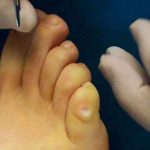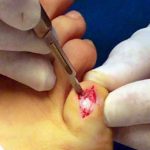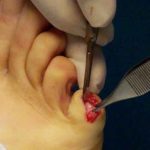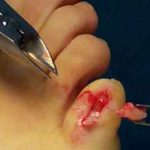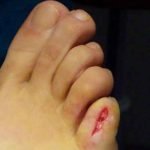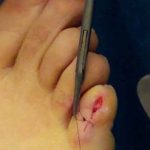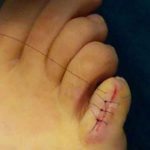Hammertoe
What is a hammertoe?
A hammertoe is a name given to contracted, curly toes that have the shape of a hammer. These deformities can become quite uncomfortable.
A hammertoe generally develops in one or two locations on a toe. A “corn” or redness can be located at the toe joint closest to the body of the foot, or at the joint closest to the toenail. Sometimes the hammertoe that forms at the joint closest to the toenail is called a “mallet toe.” Treatment for a hammertoe at either location is similar.
Frequently the affected toe can be excessively long compared to the adjacent toe.
How do I get hammertoes?
Individuals get ‘hammering of digits’ mainly due to biomechanical abnormalities during walking. Although there is an increase in occurrence with those who have flat feet, contracted toes can show up in all types of feet. Hammertoes are also increasingly common with age. Poor shoes and genetics play a role in the development of these deformities.
How do I know if I have a hammertoe?
An early sign may be that you have more difficulty or pain wearing your shoes. The longer you have a hammertoe, the more rigid and contracted the deformity can become. Most people realize they have a problem when they develop painful calluses or blisters on the top of their toes. In severe cases, ulceration and infection can develop with hammertoes. Other signs of hammertoes include painful calluses under the balls of the feet, cramping, and weakness.
Sometimes a painful area can develop between toes or on the side of the toe. This problem can be caused by a small bone spur.
How do I get rid of my hammertoes?

Contracture of the bone and corrected hammertoe
Most people start treating themselves because of painful corns on top of the toe. They try corn pads, corn removers, cushioning pads, pedicures, etc. The problem is a structural deformity within the toe and thus the above mentioned treatments are temporary and affect only the skin. The source of the problem is the contracture of the bone within the toe. In the drawing above, the toe on the left shows contracture of the toe bones, with an overlying corn (or hyperkeratosis). The toe on the right shows a corrected hammertoe, with straight toe bones, and no overlying corn. The use of larger shoes may initially help this problem, but this will not alter the underlying bone structure problem. Some milder forms of hammertoes can be improved with the use of foot orthotics. The most effective treatment is surgical correction.
What is surgery like?
The procedure can be done in the office or in an outpatient operating room using local anesthetic. The choice of the location of the surgery is dependent upon the length of time required for the surgery. Some patients prefer an outpatient operating room where sedation or anesthesia is available. If the procedure is done in the office, only local anesthesia is available. The surgery takes less than fifteen minutes per toe. Through a small incision, the bone deformity is reduced and the tendons are rebalanced around the contracted joint. About four sutures are required. The patient can walk immediately in a special post-operative shoe, using minimal or no pain medication.
What is it like after the surgery?
A moderate and gradually increasing amount of walking is allowed during the first two weeks. Minimal pain medication is usually required. The use of an ice pack and the elevation of the foot greatly decreases swelling and discomfort. Two weeks after surgery, the sutures are removed in the office and usually wide or tennis shoes can be worn.
Is surgery for me?
If you’re tired of not fitting comfortably in your shoes, getting little relief from pads, and have corns that are sensitive and painful, you might consider a surgical option.

